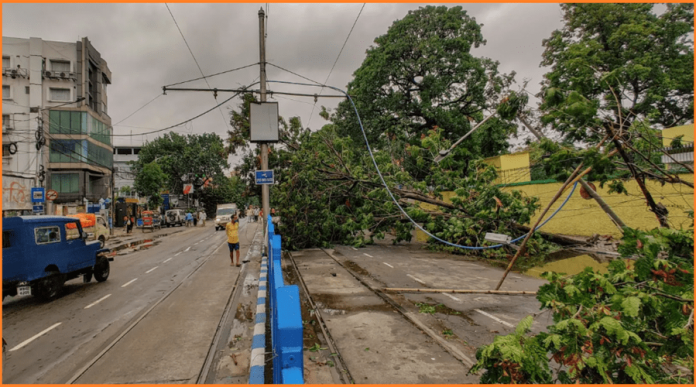The India Meteorological Department (IMD) has recently forecasted a cyclonic storm named Cyclone Michaung, which is expected to form over the southwest Bay of Bengal on Sunday, December 3. As per the latest updates, the cyclone is likely to make landfall in the coastal districts of Tamil Nadu and Andhra Pradesh on the following day. In response to this imminent threat, the government agency has issued an ‘orange’ alert for Tamil Nadu, coastal, and interior Andhra Pradesh on both Sunday and Monday.
Contents
Cyclone Michaung: Overview
Cyclone Michaung, the latest weather system in the Bay of Bengal, has gained the attention of meteorologists and authorities due to its potential impact on the southeastern coast of India. According to the IMD, the cyclonic storm is expected to intensify as it approaches the coast, bringing heavy rainfall, strong winds, and the risk of storm surges.
Orange Alert: Preparing for Impact
Recognizing the severity of the situation, the IMD has issued an ‘orange’ alert for Tamil Nadu, coastal, and interior Andhra Pradesh. The orange alert signifies that authorities and residents should be prepared for adverse weather conditions. People are advised to take necessary precautions, and local administrations are urged to make arrangements for potential evacuation efforts and ensure the safety of vulnerable communities.
Precautionary Measures:
- Evacuation Plans: Local authorities are advised to have well-defined evacuation plans in place, especially for low-lying and coastal areas that are most susceptible to the impact of the cyclone.
- Communication: Ensuring effective communication channels are critical during such events. Authorities should use various means to disseminate timely information, including weather updates, evacuation instructions, and emergency contact details.
- Shelter Arrangements: Adequate arrangements should be made for shelters, taking into account the need for social distancing in light of the ongoing COVID-19 pandemic. Proper sanitation and medical facilities should also be provided at these shelters.
- Essential Supplies: Authorities and communities are encouraged to stock up on essential supplies, including food, water, and medicines, to ensure that residents have access to basic necessities during and after the cyclone.
- Coastal Monitoring: Coastal surveillance should be intensified to monitor the development and progression of the cyclone. This includes keeping a close eye on sea conditions, tidal waves, and potential storm surges.
Cyclone Michaung poses a significant threat to the coastal regions of Tamil Nadu and Andhra Pradesh, and the IMD’s issuance of an ‘orange’ alert underscores the urgency for residents and authorities to take proactive measures. By heeding the warnings and implementing precautionary measures, the impact of the cyclone can be mitigated, and communities can better withstand the challenges posed by severe weather events. It is crucial for individuals to stay informed, follow official guidelines, and cooperate with local authorities to ensure the safety and well-being of all residents in the affected areas.
Frequently Asked Questions (FAQ) for Cyclone Michaung:
Q1: What is Cyclone Michaung? – Cyclone Michaung is a cyclonic storm forming over the southwest Bay of Bengal. It is expected to make landfall in the coastal districts of Tamil Nadu and Andhra Pradesh.
Q2: When is Cyclone Michaung expected to make landfall? – The cyclonic storm is forecasted to make landfall on Monday, December 4, after forming over the Bay of Bengal on Sunday, December 3.
Q3: What is the significance of the ‘orange’ alert issued by the IMD? – The ‘orange’ alert signifies that severe weather conditions are expected. Residents and authorities should be prepared for the impact, and precautionary measures should be taken to ensure safety.
Q4: What regions are covered by the ‘orange’ alert? – The ‘orange’ alert covers Tamil Nadu, as well as coastal and interior Andhra Pradesh, for both Sunday and Monday.
Q5: What precautions should residents take during the cyclone? – Residents are advised to follow evacuation orders, stock up on essential supplies, stay informed through official channels, and cooperate with local authorities. Essential precautions include securing homes, having an emergency kit, and staying away from coastal areas.
Q6: Are there evacuation plans in place? – Yes, local authorities are advised to have well-defined evacuation plans, especially for low-lying and coastal areas. Residents should follow official instructions regarding evacuation.
Q7: How can residents stay informed about the cyclone’s progress? – Residents should stay tuned to official weather updates from the India Meteorological Department (IMD), local authorities, and government announcements. Regularly check news sources and official social media handles for real-time information.
Q8: How can communities prepare for the cyclone in the midst of the ongoing COVID-19 pandemic? – Communities should follow COVID-19 safety protocols when evacuating or seeking shelter. This includes maintaining social distancing, wearing masks, and ensuring sanitation measures are in place at evacuation centers.
Q9: Will there be disruptions in transportation services? – There is a possibility of disruptions in transportation services, including flights, trains, and road transport. Residents are advised to check with relevant authorities and transportation providers for updates and cancellations.
Q10: What should residents do in case of an emergency during the cyclone? – In case of an emergency, residents should contact local emergency services, follow evacuation orders, and seek shelter in designated areas. Stay updated on weather conditions and cooperate with authorities for a safe response to the cyclone.





